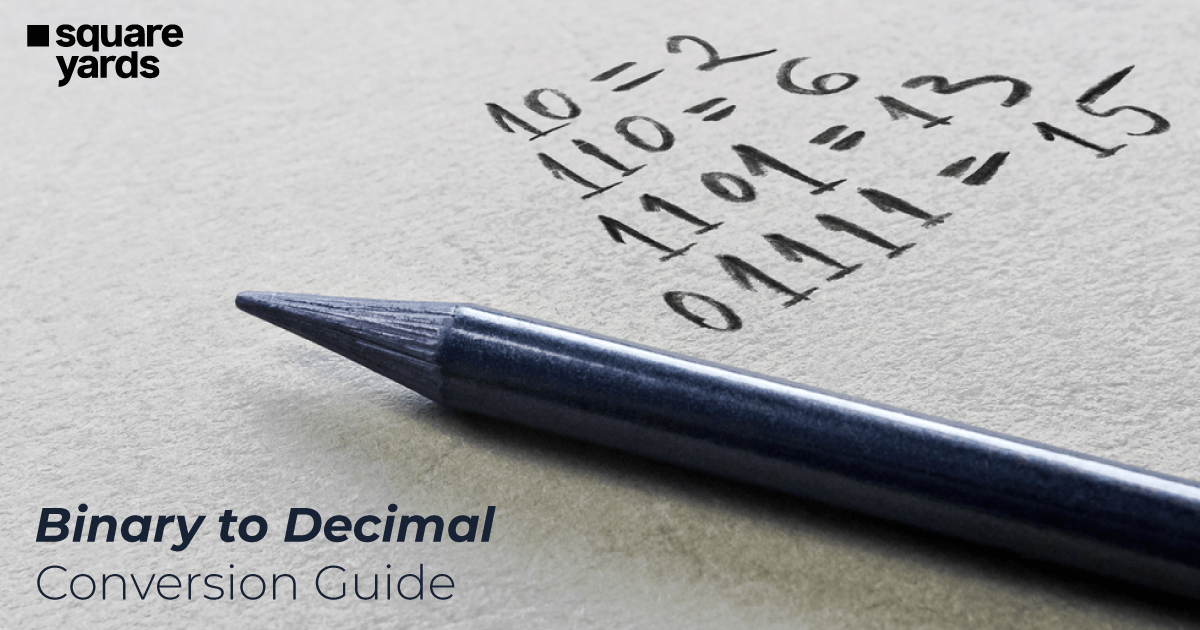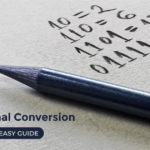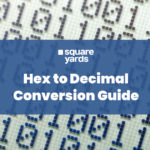In today’s digital age, where computers and electronic devices have become an integral part of our lives, understanding the fundamentals of number systems is crucial. The number system is used in many of the electrical devices we use on a daily basis and plays a crucial role in computer design. One of the fundamental conversions in number systems is the binary to decimal conversion.
This conversion allows us to interpret and manipulate binary numbers, which computers use internally, into the familiar decimal system we are accustomed to. In this blog post, we will explore the basics of binary to decimal conversion, shed light on its significance, and provide a step-by-step guide to performing the conversion.
Table of contents
What is Binary?
Binary refers to a numbering system that uses only two digits or symbols to represent numbers and data. In the context of computing and digital electronics, binary is the fundamental language used to process and store information in computers.
The two digits used in the binary system are typically 0 and 1. These digits are also known as ‘bits,’ which is short for binary digits. Each digit or bit in a binary number represents a certain power of 2. The rightmost bit represents 2^0 (1), the next bit represents 2^1 (2), the next represents 2^2 (4), and so on.
In addition to representing numerical values, binary is also used to represent other types of data, such as text, images, and sound. By converting these data types into binary format, computers can store and transmit them reliably.
Current Use of Binary
Modern technology is significantly influenced by binary numbers. They serve as the core of computers and enable the processing and representation of data. Electronic devices can do sophisticated computations, store data, and carry out tasks thanks to binary. It is essential for secure data encoding and transmission in networking and communication.
In terms of security, binary is essential to encryption since it uses challenging algorithms to protect sensitive data. For tasks like pattern recognition, new technologies like machine learning and artificial intelligence also employ binary data.
Binary instructions govern the behaviour of robots and automated systems in robotics and automation. Overall, binary numbers have several uses in a wide range of fields, helping to shape modern technology.
History of Binary
Gottfried Wilhelm Leibniz was the one who properly established binary numbers in the 17th century. Leibniz saw its potential to make computations simpler and establish a common language for computing.
The binary system became highly significant in the 20th century with the development of digital devices. Binary code is a system used by computers and other digital devices to represent information as a series of 0s and 1s. The ease of use and compatibility with digital technologies of this system have revolutionised computing and laid the groundwork for data processing, storage, and transmission in modern technology.
What is Decimal?
The decimal number system, sometimes called the base-10 system, is a numerical system that represents numbers using ten different digits (0–9). It is the most widely used number system in daily life and is heavily employed in science, maths, and computations we perform on a regular basis.
In the decimal system, each digit’s position carries a weight or value based on its position relative to the decimal point. The rightmost digit represents the one’s place, the next digit to the left represents the tens place, the next digit represents the hundreds place, and so on. The value of each digit is determined by multiplying it with the corresponding power of 10.
Current Use of Decimal
Decimal numerals are widely used in many facets of our everyday lives and in many different industries. Decimal numbers are the norm in banking and commerce for expressing money, pricing, and financial transactions. Mathematical and scientific calculations, such as measurements, equations, and statistical analysis, all need the use of decimal notation.
In everyday applications like timekeeping, where hours, minutes, and seconds are commonly stated in base-10, decimal numerals are widely used. In civil engineering, architecture, and building, decimal systems are used for accurate measurements and dimensional representation.
Decimal numerals are also widely used in database administration, spreadsheet programmes, and data analysis. Decimal numbers are the default option for the majority of human-centric interactions and systems.
History of Decimal
The base-10 system, sometimes referred to as the decimal number system, has a rich history that dates back thousands of years. It is said to have its roots in prehistoric Mesopotamia and was later advanced by cultures like the Egyptian, Greek, and Indian. The decimal system’s ease of use and suitability for common computations led to its universal acceptance.
The number has 10 digits (0-9) and is written using positional notation, in which each digit’s value is decided by where it falls in the number. The decimal system, which serves as the foundation for mathematics, business, and many other aspects of daily life, is the most widely used number system among humans today.
Relationship Between Binary and Decimal
Binary and decimal are two important number systems used in computing and mathematics. Decimal is the base-10 system used by humans, while binary is the base-2 system used by computers. A decimal has ten digits (0-9), and each digit’s value is based on its position in the number. Binary has only two digits, i.e., 0 and 1, and the positions represent powers of 2.
Converting decimal to binary involves dividing the number by 2 and noting the remainders until the quotient becomes zero. The binary representation is obtained by arranging the remainders in reverse order. For example, 14 in decimal becomes 1110 in binary.
Each digit must be multiplied by the corresponding power of 2 before being added together to convert binary to decimal. For example, 1101 in binary equals 13 in decimal.
For tasks like computer programming and digital electronics, it is essential to comprehend how binary and decimal relate to one another. It enables smooth communication between humans and computers and facilitates various operations in the digital world.
How to Convert Binary to Decimal?
Converting binary to decimal is a straightforward process. Here’s a step-by-step guide on how to do it:
Start with the binary number you want to convert to decimal. The binary number consists of only two digits, 0 and 1.
Assign a position value to each digit in the binary number, starting from the rightmost digit. The rightmost digit has a position value of 2^0 (which is 1), the next digit to the left has a position value of 2^1 (which is 2), the next digit to the left has a position value of 2^2 (which is 4), and so on.
Multiply each binary digit by its corresponding position value.
Add up all the results from the previous step. The sum of these products is the decimal equivalent of the binary number.
Formula and Examples on Binary to Decimal Conversion
Example 1: Convert Binary 1010 into Decimal
Solution:
(1 X 2^3) + (0 X 2^2) + (1 X 2^1) + (0 X 2^0)
= (1 X 8) + (0 X 4) + (1 X 2) + (0 X 1)
= 8 + 0 + 2 + 0
= 10
Example 2: Convert Binary 1101 into Decimal
Solution:
(1 X 2^3) + (1 X 2^2) + (0 X 2^1) + (1 X 2^0)
= (1 X 8) + (1 X 4) + (0 X 2) + (1 X 1)
= 8 + 4 + 0 + 1
= 13
Example 3: Convert Binary 100110 into Decimal
Solution:
(1 X 2^5) + (0 X 2^4) + (0 X 2^3) + (1 X 2^2) + (1 X 2^1) + (0 X 2^0)
= (1 X 32) + (0 X 16) + (0 X 8) + (1 X 4) + (1 X 2) + (0 X 1)
= 32 + 0 + 0 + 4 + 2 + 0
= 38
Example 4: Convert Binary 111000 into Decimal
Solution:
(1 X 2^5) + (1 X 2^4) + (1 X 2^3) + (0 X 2^2) + (0 X 2^1) + (0 X 2^0)
= (1 X 32) + (1 X 16) + (1 X 8) + (0 X 4) + (0 X 2) + (0 X 1)
= 32 + 16 + 8 + 0 + 0 + 0
= 56
Example 5: Convert Binary 1010101 into Decimal
Solution:
(1 X 2^6) + (0 X 2^5) + (1 X 2^4) + (0 X 2^3) + (1 X 2^2) + (0 X 2^1) + (1 X 2^0)
= (1 X 64) + (0 X 32) + (1 X 16) + (0 X 8) + (1 X 4) + (0 X 2) + (1 X 1)
= 64 + 0 + 16 + 0 + 4 + 0 + 1
= 85
Don’t miss It!
| Kilometer to Centimeter | Kilometer to Centimeter Conversion: Conversion Table, Examples |
| Centimeter to Meter | How to Convert Centimeter to Meter: Formula & Examples |
| Cubic Meter to Liter | How to Convert Cubic Meter to Liter: Formula & Examples |
| Cent to Square Feet | How to Convert Cent to Square Feet: Formula & Examples |
| Pounds to Kilogram | How to Convert Pounds to Kilogram: Formula & Examples |
| Milligrams to Grams | How to Convert Milligramsto Grams: Formula & Examples |
| Yard to Feet | How to Convert Yard to Feet Formula & Examples |
| Grams to Ounces | How to Convert Grams to Ounces: Formula & Examples |
Binary to Decimal Conversion Table
The binary and decimal conversion table is included below:
| BinaryNumber | DecimalNumber |
| 0 | 0 |
| 1 | 1 |
| 10 | 2 |
| 11 | 3 |
| 100 | 4 |
| 101 | 5 |
| 110 | 6 |
| 111 | 7 |
| 1000 | 8 |
| 1001 | 9 |
| 1010 | 10 |
| 1011 | 11 |
| 1100 | 12 |
| 1101 | 13 |
| 1110 | 14 |
| 1111 | 15 |
| 10000 | 16 |
| 10001 | 17 |
| 10010 | 18 |
| 10011 | 19 |
| 10100 | 20 |
| 10101 | 21 |
| 10110 | 22 |
| 10111 | 23 |
| 11000 | 24 |
| 11001 | 25 |
| 11010 | 26 |
| 11011 | 27 |
| 11100 | 28 |
| 11101 | 29 |
| 11110 | 30 |
| 11111 | 31 |
| 100000 | 32 |
| 1000000 | 64 |
| 10000000 | 128 |
| 100000000 | 256 |
Difference Between Binary and Decimal
The difference between binary and decimal is represented in the form of a table below:
| Binary Number System | Decimal Number System |
| A number system that expresses a number in terms of 0 and 1 digits is a binary number system. | The decimal number system is a numerical representation system that uses digits from 0 to 9. |
| A binary system has only two digits, i.e., 0 and 1. | With ten digits available (0, 1, 2, 3, 4, 5, 6, 7, 8, 9), the decimal number system encompasses all possible values. |
| The base of numbers in this system is 2. | The base of the decimal number system is 10. |
| Numbers in the binary system are expressed as combinations of powers of 2. | In the decimal number system, numbers are expressed as multiples of powers of 10. |
| In binary, the decimal number 26 is written as (11010)2. | The binary number (11010)2 is equivalent to the decimal number 26. |
Conclusion
Fundamentals of number systems and their conversions is becoming more and more crucial as we immerse ourselves in the world of computers and technological gadgets.
Binary to decimal conversion formula, in particular, allows us to bridge the gap between the binary system used by computers and the decimal system we are more familiar with. Understanding this conversion procedure allows us to gain the ability to interpret and work with binary numbers in a format that aligns with our human understanding.
FAQ’s about Binary to Decimal
Q1. How do you convert 10101 binary to decimal?
To convert the binary number 10101 to decimal, follow these steps:
= (1 X 2^4) + (0 X 2^3) + (1 X 2^2) + (0 X 2^1) + (1 X 2^0)
= (1 X 16) + (0 X 8) + (1 X 4) + (0 X 2) + (1 X 1)
= 16 + 0 + 4 + 0 + 1
= 21
Q2. How to convert binary to decimal 1101?
To convert the binary number 1101 to decimal, follow these steps:
= (1 X 2^3) + (1 X 2^2) + (0 X 2^1) + (1 X 2^0)
= (1 X 8) + (1 X 4) + (0 X 2) + (1 X 1)
= 8 + 4 + 0 + 1
= 13
Q3. How do you calculate binary numbers?
To calculate binary numbers from decimal numbers, you can try the easy-to-use binary to decimal calculator. binary to decimal calculator.




















